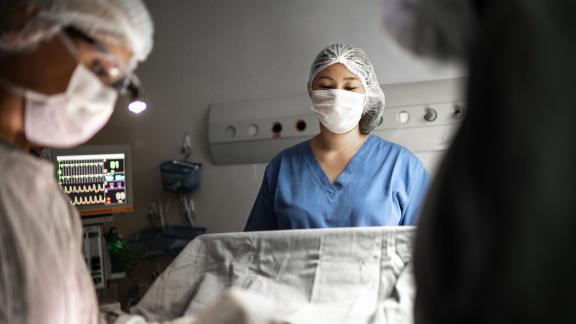Analysis: elective recovery progress and July performance statistics

At a glance
- Rising rates of COVID-19 have added to an already very busy period for urgent and emergency care, which is seeing demand and other pressures remain high into the summer – usually a period of respite for the system.
- The pressures are illustrated by the record A&E attendance and ambulance call outs in June. Pressure and lack of capacity in the rest of the patient pathway, including in social care, has added to challenges for patient flow through hospitals. The system is struggling to move people to their next care setting, with over half of patients medically fit for discharge remaining in a hospital bed. This has been a constant throughout the winter and 2022 so far.
- The fact that this level of delayed discharge has become the norm is a major concern and a sign of a system under significant strain in terms of capacity. The pandemic created a shock to our lean health service, the effective running of which relies on few disruptions and free patient flow. The latest data shows that the pandemic’s impact, in terms of ongoing cases of COVID-19, increased complexity of patients and significant backlogs of care needs, is continuing to have disruptive and cumulative knock-on effects on performance.
- Despite this, the service is continuing to ramp up elective activity giving more people access to the care they are waiting for. The highest ever number of diagnostic tests and checks were carried out for the month of May at over 2 million.
- The NHS is also making good progress on the challenging targets it has set itself, with an 85 per cent reduction in the number of people waiting over two years for elective surgery. This is down from 23,778 at the end of January, to 3,548 in the week ending 3 July.
- The service has achieved this amid a backdrop of rising staff absence, member concerns around retention, and fluctuating COVID-19 rates.
Elective recovery
The elective recovery plan set a target of delivering over 10 per cent more elective activity than before the pandemic, with this to be scaled up to 30 per cent more by 2024/25. As set out in the guidance, 6 per cent of the 10 per cent increase is expected to be delivered by reducing outpatient follow-up appointments to those initiated by patients, and improving pre-referral advice and guidance.
Efforts to increase activity to meet this target appear to be paying off, with May 2022 activity (completed pathways, both admitted and non-admitted) at 99.2 per cent of May 2019, pre-pandemic. This is an improvement on April’s national completed pathways, being at 93.3 per cent of the equivalent month in 2019/20 when adjusted for working days. This turnaround has been achieved amid high staff absence, workforce shortages, challenges with patient flow, discharges and ongoing COVID-19 prevalence.
This is also visible in the admissions figures where patients came off the waiting list due to an inpatient or day case admission. 282,535 patients were admitted in May, and when adjusted for working days this was 13,454 per day; the highest since the pandemic began and a 9.3 per cent increase on April.
The total elective waiting list rose from 6.48 million in April to 6.61 million by the end of May, and with an increase in referrals throughout May to 1.73 million (the second highest month since the pandemic began), further activity will be required to slow or make inroads into the waiting list.
The below chart shows the performance against 2019/20 and the 104 per cent target through the pandemic and at the start of 2022/23.
The latest 104-week wait figures show continued inroads in these long waiters, with the number now at 3,548 as of 3 July. The aim is for systems to have zero by the end of July. 49 trusts reported zero and 120 reported less than 50, with just nine having 100 or more.
But why are the targets for increasing overall elective activity providing such a challenge?
Workforce
Ongoing issues with staff absence have affected the capacity for trusts to work through the elective backlog. One trust told us this week that their sickness rate was currently twice its pre-COVID-19 level, which is significant over a large number of staff. The below chart shows the additional COVID-19 absences throughout this year, and perhaps one reason why the service has been able to increase elective activity again in May compared to April. The rising numbers in June and July are therefore of concern.
The latest number available from NHS England is that on 6 July, 26,874 staff were off work for COVID-19 related reasons.
Members have also expressed concerns about staff turnover rates, losing skilled staff and struggling to replace them. Further cost-of-living burdens are concerning too, which need to be addressed to avoid more leavers. Members said it was more likely they would be at 80 per cent of pre-COVID-19 activity levels in 2024/25 than 130 per cent.
Other trusts have reported theatre staff being a key constraint, hampering the ability to get through surgery.
The latest published vacancy figures showed 105,855 FTE vacancies across the service, which may be higher due to data flow issues.
Urgent care and patient flow
The latest data shows that on an average day in June, 56.7 per cent of patients who no longer meet the criteria to reside remained in hospital. This has been a problem throughout winter and 2022 despite efforts to improve discharge flows, with social care capacity and delays in other parts of the system such as community causing ongoing challenges.
Data available pre-pandemic showed delays attributed to social care to range between 24.5 per cent and 38.1 per cent, although no data is currently being publicly released on reasons for these delayed discharges.
On Tuesday 12 July it was reported that all of England’s ambulance services were at Resource Escalation Action Plan (REAP) level 4 - the equivalent of a hospital black alert. Ongoing pressures with absence, the hot weather and flow as above mean ambulance handover delays continue to be a problem. The latest data from the Association of Ambulance Chief Executives (AACE) show that handovers over 60 minutes increased to their third highest volume to date, with 41,000 delays across June. That’s 13 per cent of all handovers, but for some trusts on some days the proportion was higher than 30 per cent. The latest standards indicate there should be zero over 60 minutes, and the latest numbers represent a rise after two months of decreases. The data also showed nearly 11,000 patient handovers taking over three hours in the month.
Pressures in A&E also continue, with members reflecting that continuing challenges in A&E risk diverting resources away from the elective recovery. The percentage of people seen within four hours at type 1 A&E departments dropped to 58.8 per cent in June, which is the second worst on record after 58.7 per cent in March 2022. Meanwhile, 12-hour trolley waits rose to 22,034 having dropped from over 24,000 to 19,053 in May.
COVID-19
The latest data is encouraging, showing that the growth in admissions has started to slow as we appear to be approaching another peak, but the NHS remains under pressure from COVID-19. On 11 July, daily admissions were over 2,000 (up 4.9 per cent week on week), and over 13,700 patients were in hospital with COVID-19 (up 19.9 per cent week on week).
The latest primary diagnosis supplement showed that on the most recent day available, 36.9 per cent of COVID-19 patients in hospital were in hospital ‘for’ as opposed to ‘with’ COVID-19, although this varies from 22.1 per cent in London to 53.6 per cent in the south west.
Peaks of COVID-19 admissions, which we saw in late December/early January, then late March/early April, and now July, all impinge on the service’s ability to return to 2019/20 levels of elective activity and make inroads into the waiting list.
The latest figure for patients in hospital with COVID-19 of 13,741 is 17.2 per cent lower than the April peak (16,600) and 19.7 per cent lower than January’s (17,120), although the current number is still on the rise.
Conclusion
The service has made marked improvements in May in terms of completed elective activity, with completed pathways at over 99 per cent of the same time in 2019/20. However, they remain short of targets to ramp up elective activity.
Members tell us that problems with workforce, patient flow and discharge into social care and community, A&E pressures and COVID-19 are all heavily affecting the service’s ability to make inroads into the waiting list, which now stands at 6.61 million. The data backs this up.
There’s a need for honesty and realism about what our members can do with these constraints, especially as extreme weather and a forthcoming COVID-19 hospital admissions peak threaten to create further problems for the service. Members have also told us about their concerns in implementing patient choice, with the variation in capacity and current pressures needing to be taken into account.
In this turbulent political context, the elective backlog and NHS funding are some of the biggest issues the new Prime Minister is going to face.
How is the NHS performing?
View our analysis of the latest NHS performance figures for a rounded view of how healthcare services are coping under immense pressure.



